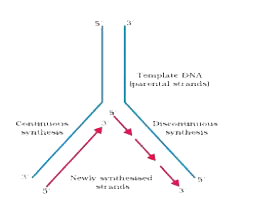Explain the mechanism of DNA replication as suggested by Watson and Crick.
Video Solution
Text Solution
Mechanism of Replication of DNA suggested by Watson and Crick
• The two strands of DNA would separate and act as a template for the synthesis of new complementary strands. After the completion of replication, each DNA molecule would have one parental and one newly synthesised strand. This scheme was termed as semiconservative replication of DNA.
• In living cells, such as E. coli, the process of replication requires a set of catalysts (enzymes). The main enzyme is referred to as DNA-dependent DNA polymerase, since it uses a DNA template to catalyse the polymerisation of deoxynucleotides.
• Furthermore, energetically replication is a very expensive process. Deoxyribonucleoside triphosphates serve dual purposes. In addition to acting as substrates, they provide energy for polymerisation reaction.
• For long DNA molecules, since the two strands of DNA cannot be separated in its entire length (due to very high energyrequirement), the replication occurs within a small opening of the DNA helix, referred to as replication fork.
• The DNA-dependent DNA polymerases catalyse polymerisation only in one direction, that is 5 → 3.
• Consequently, on one strand (the template with polarity 3 5), the replication is continuous, while on the other (the template with polarity 5 → 3), it is discontinuous. The discontinuously synthesised fragments are later joined by the enzyme DNA ligase.

Figure:
replication Fork
• The DNA polymerases on their own cannot initiate the process of replication.
• There is a definite region in E. coli DNA where the replicationoriginates, such regions are termed as origin of replication.
• In eukaryotes, the replication of DNA takes place at S-phase of the cell- cycle.
• The replication of DNA and cell - division cycle should be highly coordinated. A failure in cell division after DNA replication results into polyploidy.
|
Topper's Solved these Questions
Similar Questions
Knowledge Check
DNA replication is
AConservative and discontinuousBSemiconservative and semi-discontinuousCSemiconservative and discontinuousDConservativeDNA replication is :
AConservative and discontinuousBSemiconservative and semi-discontinuousCSemiconservative and discontinuousDConservativeDNA replication is :
AConservative and discontinuousBSemiconservative and semi-discontinuousCSemiconservative and discontinuousDConservative
Explain the mechanism of DNA repication with the help of a replication fork. What role does the enzyme DNA-ligase play in a DNA replication fork ?
OR
Construct and label a transcription unit from which the RNA segment given below has been transcribed. Write the complete name of the enzyme that transcribed this RNA.

View SolutionExplain semiconservative mode of DNA replication.
View SolutionDNA replication is:-
View SolutionDNA replicates-
View Solution[A]: Meselson and Stahl tested the Watson and Crick Theory of DNA replication.
[R]: They confirmed the mechanism of DNA replication by using the isotopic and Centrifu- gation technique
View Solution
